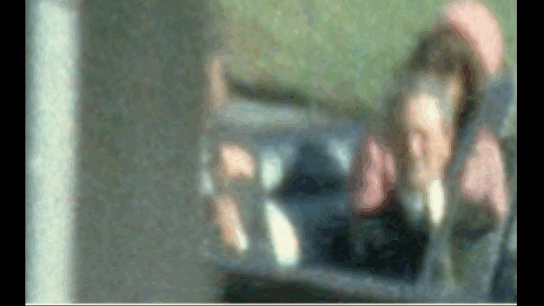Both men are shot through in z224, the time it takes for the bullet to pass through both men is so small we can, for our purposes, consider it instantaneous. In z225 JFK's hand begins to snap shut, this is a reflex that probably indicates the bullet that has passed through him, very close to his spine and high up on his back, has severed one of the plexus of nerves that emanates from this part of the spinal column and are directly connected to the hand.
However, it's not a reaction to the bullet, it's a reflex. We see the reaction of both men to being shot in z226, Kennedy's left elbow is raised into view, his right hand has snapped fully shut and is moving towards his throat. Connally's Stetson begins to shoot up, this is the first moment of the sudden thrashing around and twisting in his seat that can clearly be seen in the full Zfilm.

Hello Dan
The best study on the exact timing of the bullet that struck both men was conducted by Dr. Lattimer back in the 1990’s. He used neck from a hog and a rib cage from a hog. The rib cage had a shirt button around it, a neck tie was knotted and a coat placed over it, as a model for the Governor. A Carcano rifle with WCC/MC bullets was fired through both the “neck” and the “torso” models, separated by 24 inches.
It is all described below:
https://mcadams.posc.mu.edu/Lattimer.txtThis test showed that the coat’s maximum movement, its maximum bulge, occurred 3/30 of a second after bullet impact. It appears the movement was caused not by the bullet, which passed through at 0/30 seconds, slicing through the coat without moving it much, but by debris that came flying out of the chest wound and struck the coat, causing the whole right side of the coat to swing forward and perhaps the lapel to flip upward. It’s hard for me to tell what happened in the Zapruder film other than the coat moved.
The coat movement reached its peak at z224. 3/30 of a second before, or 1/10 of a second before, corresponds to Frame 222. Until better tests are run than those conducted by Dr. Lattimer, Frame 222 has to be considered as the most likely moment of impact.
This also corresponds with the strong camera jiggle of Mr. Zapruder’s camera that occurs at z227. The Camera Jiggle, judging by the strong camera jiggle at z318, should occur 5 to 6 frames after a bullet strike, so this corresponds to frame 222 better than frame 224.
So, the bullet was fired at z220. The bullet struck both men at frame 222. By frame 224 the coat’s forward movement reaches its maximum. And by frame 226, both the President’s and the Governor’s right arm abruptly starts rising.
As an aside, I would urge caution in putting the bullet impact too late. A strike at z224, or even z223, opens the door up to CTers to go to their standard claim “The reactions are too fast to be humanly possible”. Popular for both the z222 and the z312 bullet strike. They would make the same claim about a third strike on the President or the Governor if we LNers believed there was a third strike. Frame 222 is the best estimate. I’m not placing it earlier than it should be, except a CTer might point out that z222 is 110 milliseconds before z224, not 100. Even so, Frame 222 is the best estimate we have, subject to future testing of the nature Dr. Lattimer carried out.